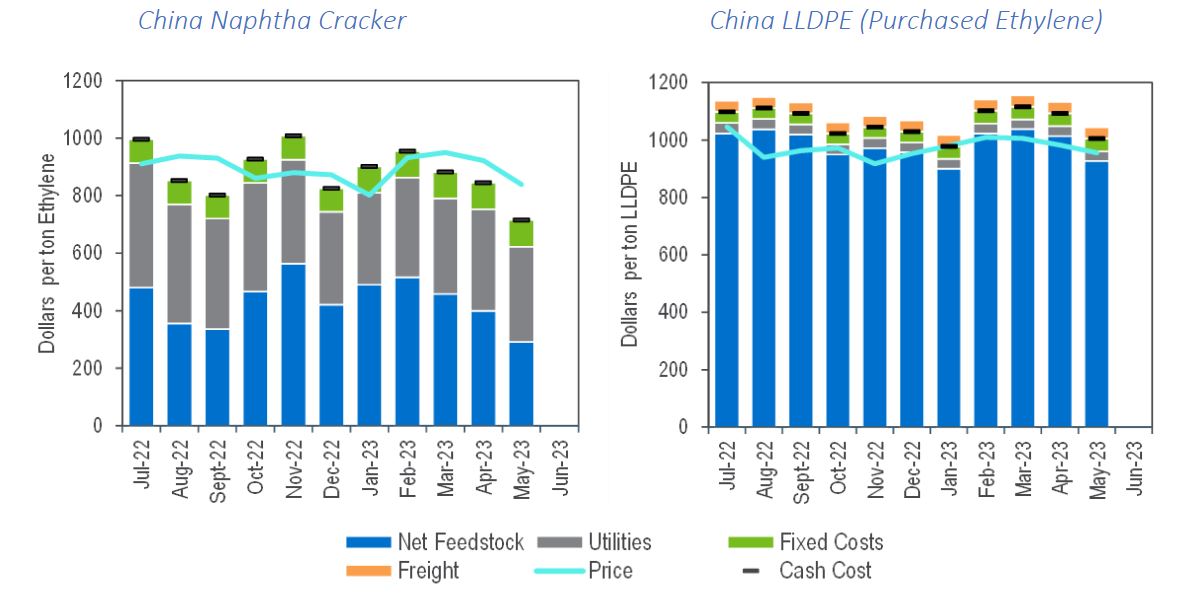Petrochemicals and polymers: Quarter two performance

Weakening Asian markets stalled hopes for brisk recovery of global industry as post-COVID economic transition in China fell short of expectations. Modest margin gains earned to easing feedstock costs were conceded to derivatives where most competitive prices had to be offered to secure placement.
A harsh economic climate in Western markets slowed demand for petrochemicals through the second half of 2022. Activity in the manufacturing sector bore the brunt of economic pressures as intense cost pressure on consumers stalled discretionary consumer spending. Potential for robust demand growth alongside liberation of economic activity accompanying lifting of COVID-19 restrictions in China lent optimism to markets, signalled in a renewed upturn of Asian prices into 2023.
Easing feedstock costs offered support to flagging margins through quarter two. Sentiment in Asian markets deteriorated abruptly as post COVID economic transition in China stalled and the rapid pace of capacity expansion risked deepening supply excess. Ethylene capacity in China has increased more than 12 percent every year since 2019 and is set to double by 2024. Abrupt turn in market sentiment reversed recent gains in Asian prices masking the influence of upstream cost savings. Margins of integrated polyethylene producers in Asia languished near cash cost breakeven. Western markets were exposed to renewed weakness emerging in Asian markets as keen pricing was necessary to clear surplus supply in deeply contested export markets.
China Production Costs ($/ton)
China Production Costs ($/ton)
The recently published NexantECA Quarterly Business Analysis report addresses current trends in cost, price, and margin for a broad range of commodity perochemicals. Slack demand and intense competition to place surplus material in lengthy markets consistently challenged profitability. Weak markets capped prices and impeded opportunity to realise upstream cost savings as global energy markets continued to relax.
Slack demand for exports of manufactured goods to Western markets compromised petrochemical demand in Asia and truncated the anticipated upside of post-COVID economic transition in China
Asian petrochemical markets weakened with frail demand diverging from lengthening supply. Demand for most petrochemicals fell short of expectations as confidence in the economic climate stalled. Slow pace of recovery in China was particularly ominous as transition to post-COVID economic activity had been expected to support a strong upturn. Demand constraints accompanying tightening fiscal policy and stubborn inflationary pressures in Western markets were increasingly apparent in Asian markets. Deeper restraint in discretionary consumer spending in Western markets curbed exports of manufactured goods. Slow manufacturing industry throughput backed out demand for commodity petrochemicals and polymers. A busy period of scheduled maintenance initially masked deepening demand side pressure but market weakness was transparent as plants restarted.
Weakening markets and easing upstream costs led Asian producers to concede price. A brief price upturn in the opening months of the year was soon reversed as market sentiment turned. Fragile petrochemical demand for naphtha diverged from more resilient demand for gasoline. Widening crack spreads at the refinery extended potential feedstock cost savings as a weakening view of crude oil markets depressed oil prices. Margin gained to easing upstream cost was in many cases surrendered to frail derivative margins. Profitability of integrated polyethylene units languished near cash cost breakeven.
Fading consumer confidence retained stagnant demand and a tight focus on inventory management across the European petrochemical industry. Easing upstream costs revived margins against weakening markets.
Demand for commodity petrochemicals in Western Europe remained weak as derivative consumers held nominated offtake at minimum contractual obligations. Little upturn in demand was apparent into the summer season as discretionary consumer spending remained heavily curtailed by inflationary pressures. Increasing interest rates countered relief in the energy cost burden. Economic activity across the Euro-zone contracted for two consecutive quarters and annual GDP growth dropped below one percent.
Commodity petrochemical markets in Western Europe lengthened with a relatively light slate of scheduled maintenance after some turnarounds were pulled forwards. Little confidence in the prospects for any significant upturn in demand before the end of the year prompted a strong focus on inventory management and operating rates were turned down below 70 percent. A steady downturn in production costs headed by easing feedstock costs offered scope to revive margin surrendered in the opening quarter of the year. Limited availability of import cargoes eased pressure on derivative prices. Average industry profitability rebounded from the ten year low suffered in previous six months.
Return of cost advantaged gas to the United States did little to revive flagging profitability. Keen pricing was essential to clear surplus volume in fragile domestic and export markets.
Easing feedstock costs offered some optimism as natural gas prices in the United States fell heavily for a third consecutive quarter and approached US$2/mmBTU for the first time in three years. Ethane prices closely followed the downturn in gas costs and tumbled 66 percent on the year to settle at a three-year low. The steep downturn in gas costs restored a considerable cost advantage to ethane as the lowest cost source of ethylene in the United States.
Domestic demand stalled as the United States led tightening fiscal policy in a bid to curb escalating inflationary pressures. Weakening export markets compounded pressure on petrochemical markets in the United States where domestic demand remained stagnant. The widening cost advantage enjoyed through the first half the year was swiftly conceded into lower prices in a bid to retain business in increasingly contested export markets. Average industry profitability rolled over from quarter one and remains at the lower end of the range achieved over last decade.
Profitability of petrochemical exports from Middle East strengthened little from 20 year low found in second half of 2022. Rapid capacity expansion in China dispelled upturn sought from lifting of last COVID restrictions.
Petrochemical producers in Middle East faced stiff competition placing export cargoes as supplies in crucial Asian markets lengthened and the post COVID economic transition in China lost momentum. Cost advantage of feedstocks derived from low cost gas in Middle East diminished as the sharp peak in global gas prices built as energy markets were pinched critically tight emerging from COVID pandemic was cleared. Intense competition to clear export cargoes in fragile Asian markets capped netbacks as demand fell short of expectations. Profitability of export business remains at lower end of the last two decades excluding the distressed oil prices in first half of 2020 as the COVID-19 pandemic blighted global markets.
Find out more...
Quarterly Business Analysis: Global - Petrochemicals, Polymers and C1 Chemicals - Q2 2023
The Quarterly Business Analysis provides key insight into production economics for a broad range of commodity petrochemicals, polymers and C1 chemicals. The analysis presents a review of costs, prices and margins for typical production assets, providing a valuable view of regional and value chain competitiveness and is is available for each key price setting region - Asia Pacific, Middle East, Western Europe and the United States. A quarterly report provides insightful commentary to illustrate current trends, related to recent market developments. The accompanying database is updated monthly.
Upcoming webinar...
In this 45 minute webinar, NexantECA will present its views on the industry performance during the second quarter of 2023, as well as summarise how petrochemical production economics have reacted, sourcing material from the Quarterly Business Analysis reports.
Wednesday, July19, 2023 @ 9AM BST
Duration: 45 minutes
Wednesday, July 19, 2023 @ 2PM BST
Duration: 45 minutes
About the Author...
Andrew Powell, Project Manager
Andrew has 20 years of experience analysing petrochemical industry performance with NexantECA. He is an expert in assessing production economics and preparing price forecasts spanning the full petrochemical industry value chain, from refinery to specialty chemicals. Andrew leads development of NexantECA Subscriptions analysis of profitability and pricing across the global petrochemical industry.

